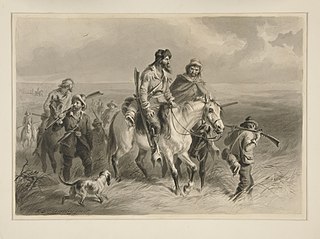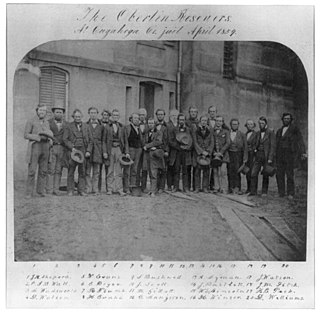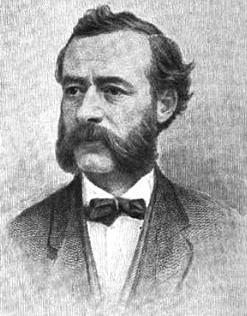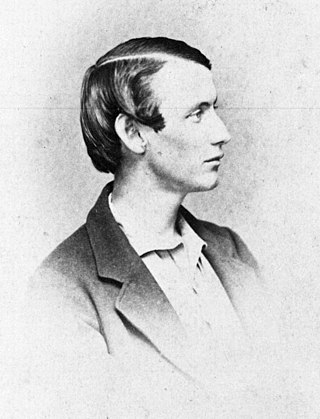
John Brown was an American abolitionist leader. First reaching national prominence for his radical abolitionism and fighting in Bleeding Kansas, he was eventually captured and executed for a failed incitement of a slave rebellion at Harpers Ferry preceding the American Civil War.

Bleeding Kansas, Bloody Kansas, or the Border War was a series of violent civil confrontations in Kansas Territory, and to a lesser extent in western Missouri, between 1854 and 1859. It emerged from a political and ideological debate over the legality of slavery in the proposed state of Kansas.

Silas Stillman Soule was an American abolitionist, military officer and 'conductor' on the Underground Railroad. As a Kansas Jayhawker, he supported and was a proponent of John Brown's movement in the time of strife leading up to the American Civil War.

Quantrill's Raiders were the best-known of the pro-Confederate partisan guerrillas who fought in the American Civil War. Their leader was William Quantrill and they included Jesse James and his brother Frank.

The Lawrence Massacre, also known as Quantrill's Raid, was an attack during the American Civil War (1861–65) by Quantrill's Raiders, a Confederate guerrilla group led by William Quantrill, on the Unionist town of Lawrence, Kansas, killing around 150 unarmed men and boys.

Border ruffians were proslavery raiders, crossing from the slave state of Missouri into the Kansas Territory, to help ensure Kansas entered the Union as a slave state. They were a key part of the violent period called Bleeding Kansas, that peaked from 1854 to 1858. Their crimes included fraudulent voting, interference with elections, and raiding, intimidating, and destroying property of "Free-State" (anti-slavery) settlers. Some took pride in their criminal reputation. Many became pro-Confederate guerrillas, or bushwhackers.
The Pottawatomie massacre occurred on the night of May 24–25, 1856, in the Kansas Territory. In reaction to the sacking of Lawrence by pro-slavery forces on May 21, and the telegraphed news of the severe attack on May 22 on Massachusetts Senator Charles Sumner, for speaking out against slavery in Kansas, John Brown and a band of abolitionist settlers—some of them members of the Pottawatomie Rifles—made a violent reply. Just north of Pottawatomie Creek, in Franklin County, they killed five pro-slavery settlers in front of their families. This soon became the most famous of the many violent episodes of the "Bleeding Kansas" period, during which a state-level civil war in the Kansas Territory was described as a "tragic prelude" to the American Civil War which soon followed. "Bleeding Kansas" involved conflicts between pro- and anti-slavery settlers over whether the Kansas Territory would enter the Union as a slave state or a free state. It is also John Brown's most questionable act, both to his friends and his enemies. In the words of abolitionist Frederick Douglass, it was "a terrible remedy for a terrible malady."

Samuel Forster Tappan was an American journalist, military officer, abolitionist and a Native American rights activist. Appointed as a member of the Indian Peace Commission in 1867 to reach peace with the Plains Indians, he advocated self-determination for native tribes. He proposed the federal government replace military jurisdiction over tribal matters with a form of civil law on reservations, applied by the tribes themselves.
The Wakarusa War was an armed standoff that took place in the Kansas Territory during November and December 1855. It is often cited by historians as the first instance of violence during the "Bleeding Kansas" conflict between anti-slavery and pro-slavery factions in the region.

The Oberlin–Wellington Rescue of 1858 in was a key event in the history of abolitionism in the United States. A cause celèbre and widely publicized, thanks in part to the new telegraph, it is one of the series of events leading up to Civil War.

The Battle of Black Jack took place on June 2, 1856, when antislavery forces, led by the noted abolitionist John Brown, attacked the encampment of Henry C. Pate near Baldwin City, Kansas. The battle is cited as one incident of "Bleeding Kansas" and a contributing factor leading up to the American Civil War of 1861 to 1865.
The Battle of Osawatomie was an armed engagement that occurred on August 30, 1856, when 250–400 pro-slavery Border ruffians, led by John W. Reid, attacked the town of Osawatomie, Kansas, which had been settled largely by anti-slavery Free-Staters. Reid was intent on destroying the Free-State settlement and then moving on to Topeka and Lawrence to do more of the same. Abolitionist John Brown first learned of the raiders when they shot his son Frederick. With just 40 or so men, Brown tried to defend the town against the pro-slavery partisans, but ultimately was forced to withdraw; five Free-Staters were killed in the battle, and the town of Osawatomie was subsequently looted and burned by Reid's men. The battle was one of a series of violent clashes between abolitionists and pro-slavery partisans in Kansas and Missouri during the Bleeding Kansas era.

Lewis Sheridan Leary was an African-American harnessmaker from Oberlin, Ohio, who joined John Brown's raid on Harpers Ferry, where he was killed.

The Reverse Underground Railroad is the name given, sardonically, to the pre-American Civil War practice of kidnapping in free states not only fugitive slaves but free blacks as well, transporting them to slave states, and selling them as slaves, or occasionally getting a reward for return of a fugitive. Those who used the term were pro-slavery and angered at an "underground railroad" helping slaves escape. Also, the so-called "reverse underground railroad" had incidents but not a network, and its activities did not always take place in secret. Rescues of blacks being kidnapped were unusual.

John Anthony Copeland Jr. was born free in Raleigh, North Carolina, one of the eight children born to John Copeland Sr. and his wife Delilah Evans, free mulattos, who married in Raleigh in 1831. Delilah was born free, while John was manumitted in the will of his master. In 1843 the family moved north, to the abolitionist center of Oberlin, Ohio, where he later attended Oberlin College's preparatory division. He was a highly visible leader in the successful Oberlin-Wellington Rescue of 1858, for which he was indicted but not tried. Copeland joined John Brown's raid on Harpers Ferry; other than Brown himself, he was the only member of John Brown's raiders that was at all well known. He was captured, and a marshal from Ohio came to Charles Town to serve him with the indictment. He was indicted a second time, for murder and conspiracy to incite slaves to rebellion. He was found guilty and was hanged on December 16, 1859. There were 1,600 spectators. His family tried but failed to recover his body, which was taken by medical students for dissection, and the bones discarded.

The history of large-scale slavery in the region which later became the State of Missouri began in 1720, when a French merchant named Philippe François Renault brought about 500 slaves of African descent from Saint-Domingue up the Mississippi River to work in lead mines in what is now southeastern Missouri and southern Illinois. These people were the first enslaved Africans brought en masse to the middle Mississippi River Valley. Prior to Renault's enterprise, slavery in Missouri under French colonial rule had been practiced on a much smaller scale as compared to elsewhere in the French colonies.
Charles Henry Langston (1817–1892) was an American abolitionist and political activist who was active in Ohio and later in Kansas, during and after the American Civil War, where he worked for black suffrage and other civil rights. He was a spokesman for blacks of Kansas and "the West".

James Redpath was an American journalist and anti-slavery activist.

John Henry Kagi, also spelled John Henri Kagi, was an American attorney, abolitionist, and second in command to John Brown in Brown's failed raid on Harper's Ferry. He bore the title of "Secretary of War" in Brown's "provisional government." At age 24, Kagi was killed during the raid. He had previously been active in fighting on the abolitionist side in 1856 in "Bleeding Kansas". He was an excellent debater and speaker.

George Henry Hoyt was an anti-slavery abolitionist who was attorney for John Brown. During the Civil War, he served as a Union cavalry officer and captain of the Kansas Red Leg scouts, rising to the rank of brevet brigadier general by war's end. Following the war, Hoyt served as the sixth Attorney General of Kansas.
!["The Immortal Ten", Lawrence, Kansas Territory, 1859. Standing, from left to right: Major James B. Abbott, Captain Joshua A. Pike, Jacob Senix, Joseph Gardner, Thomas Simmons, S.J. Willis, Charles Doy, Captain John E. Stuart [Stewart], Silas Soule, and George R. Hay. Seated in front: Dr. John Doy. John Doy and rescue party.jpg](http://upload.wikimedia.org/wikipedia/commons/thumb/3/33/John_Doy_and_rescue_party.jpg/300px-John_Doy_and_rescue_party.jpg)
















